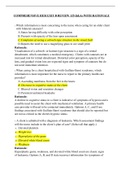Samenvatting
Summary Pricing and Revenue Analytics 2022/2023 - All Lectures and Web Clips
- Vak
- Instelling
Summary of all the papers, web clips, lectures, and tutorials (incl. answers) and web clips for the course Pricing and Revenue Analytics. Not in a bullet-list type of way so you have to figure everything out yourself, but in clear, concise language. This file contains all the materials discussed in...
[Meer zien]










